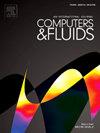Kinetic and macroscopic modelling for dense gas flow simulations
IF 2.5
3区 工程技术
Q3 COMPUTER SCIENCE, INTERDISCIPLINARY APPLICATIONS
引用次数: 0
Abstract
This study delves into the complexities of modelling dense gases near thermodynamic critical points, where conventional gas dynamic assumptions prove inadequate. Within this unique regime, non-linear waves exhibit behaviours divergent from classical phenomena, like expansion shocks which remain consistent with entropy conditions. Accurately capturing these phenomena mandates sophisticated equation of state (EoS) that surpasses the ideal gas assumptions, presenting challenges for numerical simulations. In this paper, we propose a simple modification to the Boltzmann equation (with the BGK framework), which, upon taking moments, leads to Euler equations for dense gas flows. We consider van der Waals EoS. Further, we develop a three-velocity model based Kinetic Flux Difference Splitting (KFDS) scheme for the Euler system, with adaptable diffusion coefficients suitable to capture compressible flow phenomena specific to ideal and dense gases. This innovative approach diverges from traditional algorithms, which are tailored for ideal gas EoS and struggle to accommodate the inherent variations. A comparative analysis with macroscopic efficient central solvers designed to be independent of the eigen-structure, such as MOVERS+ and RICCA, is conducted to validate the results against benchmark tests from the data in the literature. It is important to note that the kinetic schemes also possess the advantage of being independent of the eigen-structure, a feature that distinguishes them from traditional Riemann solvers. This effort significantly enhances computational modelling capabilities and fosters deeper insights into the behaviour of dense gases. The proposed advancements enhance numerical methods tailored for real gas EoS simulations by ensuring precise capture of grid-aligned steady discontinuities and effectively mitigating numerical diffusion across these discontinuities in inviscid compressible flows.
稠密气体流动模拟的动力学和宏观模型
本研究深入研究了在热力学临界点附近模拟致密气体的复杂性,传统的气体动力学假设被证明是不充分的。在这种独特的状态下,非线性波表现出与经典现象不同的行为,比如与熵条件保持一致的膨胀冲击。准确地捕捉这些现象需要复杂的状态方程(EoS),它超越了理想气体的假设,这给数值模拟带来了挑战。在本文中,我们对玻尔兹曼方程(具有BGK框架)提出了一个简单的修正,该修正在取矩后可得到稠密气体流动的欧拉方程。我们考虑范德华方程。此外,我们为欧拉系统开发了一种基于三速度模型的动力学通量差分分裂(KFDS)方案,该方案具有可适应的扩散系数,适用于捕获理想气体和致密气体特有的可压缩流动现象。这种创新的方法与传统算法不同,传统算法是为理想气体EoS量身定制的,难以适应固有的变化。与设计为独立于特征结构的宏观高效中心求解器(如MOVERS+和RICCA)进行比较分析,通过文献中数据的基准测试验证结果。值得注意的是,动力学方案还具有独立于本征结构的优势,这是将其与传统黎曼解算法区分开来的一个特征。这项工作大大提高了计算建模能力,并促进了对致密气体行为的更深入了解。所提出的进展通过确保精确捕获网格对准的稳定不连续面,并有效减轻非粘性可压缩流动中这些不连续面的数值扩散,增强了为真实气体EoS模拟量身定制的数值方法。
本文章由计算机程序翻译,如有差异,请以英文原文为准。
求助全文
约1分钟内获得全文
求助全文
来源期刊

Computers & Fluids
物理-计算机:跨学科应用
CiteScore
5.30
自引率
7.10%
发文量
242
审稿时长
10.8 months
期刊介绍:
Computers & Fluids is multidisciplinary. The term ''fluid'' is interpreted in the broadest sense. Hydro- and aerodynamics, high-speed and physical gas dynamics, turbulence and flow stability, multiphase flow, rheology, tribology and fluid-structure interaction are all of interest, provided that computer technique plays a significant role in the associated studies or design methodology.
 求助内容:
求助内容: 应助结果提醒方式:
应助结果提醒方式:


